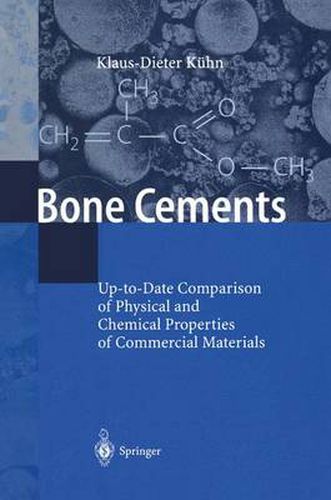Readings Newsletter
Become a Readings Member to make your shopping experience even easier.
Sign in or sign up for free!
You’re not far away from qualifying for FREE standard shipping within Australia
You’ve qualified for FREE standard shipping within Australia
The cart is loading…






This title is printed to order. This book may have been self-published. If so, we cannot guarantee the quality of the content. In the main most books will have gone through the editing process however some may not. We therefore suggest that you be aware of this before ordering this book. If in doubt check either the author or publisher’s details as we are unable to accept any returns unless they are faulty. Please contact us if you have any questions.
Methyl methacrylate (MMA) is the basic component of bone cements. To use it, a dough is prepared from the liquid and powder by mixing right before application, which is normally done by the operating team. During its working phase the dough is then inserted into the tissue where polymerization is completed. Thus, the final implant polymethyl methacrylate (PMMA) is only created at the implantation site. Besides methyl methacrylate, bone cements sometimes contain other methacrylates, such as butyl methacrylate. To achieve X-ray opacity, radiopacifiers (zirconium dioxide or barium sulfate) are added to the powder. Both the liquid and powder components contain additives (initiator and activator) that launch polymerization and control the set ting when mixed together. Moreover, softener and emulsifiers are some times used. The addition of antibiotics to the powder component in order to prevent or treat infections has become especially important. Commercial bone cements differ in composition and the course of curing. Some are designed for high and others for low viscosity. The way the user handles and applies the cement always crucially influences the quality of the implant. This is why clear and comprehensive information about the cements should be available to show the user how all the relevant factors work It should also be possible together and how they depend on each other.
$9.00 standard shipping within Australia
FREE standard shipping within Australia for orders over $100.00
Express & International shipping calculated at checkout
This title is printed to order. This book may have been self-published. If so, we cannot guarantee the quality of the content. In the main most books will have gone through the editing process however some may not. We therefore suggest that you be aware of this before ordering this book. If in doubt check either the author or publisher’s details as we are unable to accept any returns unless they are faulty. Please contact us if you have any questions.
Methyl methacrylate (MMA) is the basic component of bone cements. To use it, a dough is prepared from the liquid and powder by mixing right before application, which is normally done by the operating team. During its working phase the dough is then inserted into the tissue where polymerization is completed. Thus, the final implant polymethyl methacrylate (PMMA) is only created at the implantation site. Besides methyl methacrylate, bone cements sometimes contain other methacrylates, such as butyl methacrylate. To achieve X-ray opacity, radiopacifiers (zirconium dioxide or barium sulfate) are added to the powder. Both the liquid and powder components contain additives (initiator and activator) that launch polymerization and control the set ting when mixed together. Moreover, softener and emulsifiers are some times used. The addition of antibiotics to the powder component in order to prevent or treat infections has become especially important. Commercial bone cements differ in composition and the course of curing. Some are designed for high and others for low viscosity. The way the user handles and applies the cement always crucially influences the quality of the implant. This is why clear and comprehensive information about the cements should be available to show the user how all the relevant factors work It should also be possible together and how they depend on each other.